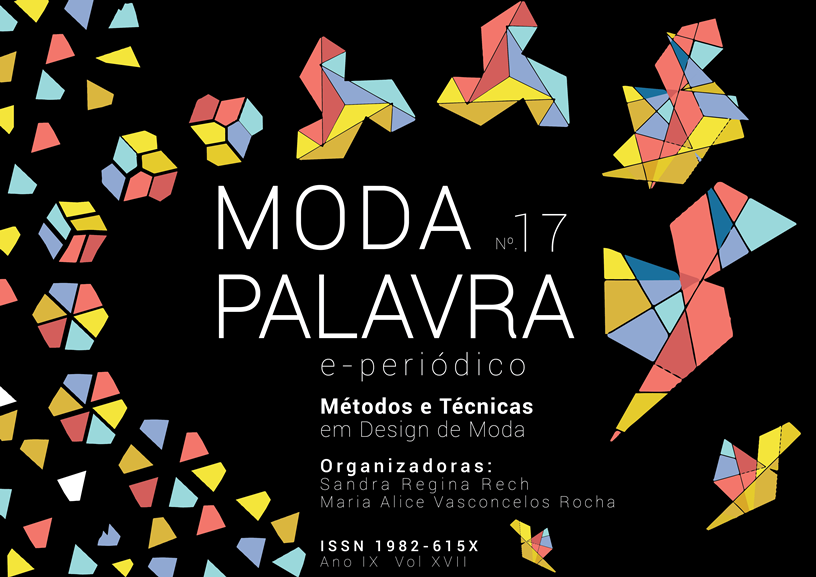O corte a laser na marchetaria em couro: o processo de design com reaproveitamento dos rejeitos
DOI:
https://doi.org/10.5965/1982615x09172016268Palavras-chave:
rejeitos de couro, tecnologia de corte a laser, produtos de modaResumo
O objetivo deste trabalho foi apresentar o processo de marchetaria em couro, com a utilização da tecnologia de corte a laser, aplicado em rejeitos de couro para o desenvolvimento de produtos de design de moda. Este trabalho foi desenvolvido a partir do estudo de caso da marca Brantê, cujos dados foram coletados por meio de observação e entrevistas informais. Ao final do estudo, constatou-se que a marchetaria em couro com utilização de corte a laser é um processo passível de ser aplicado em diversos tipos de produtos; também percebeu-se que os produtos desenvolvidos pela Brantê obtêm destaque no mercado por apresentarem valor estético e simbólico resultantes de um processo de design diferenciado. O reaproveitamento do couro também contribui para o resultado alcançado pela empresa no mercado, uma vez que o processo é adequado aos padrões dos produtos que são desenvolvidos, obedecendo a critérios de qualidade para o reaproveitamento de um material descartado anteriormente.
Downloads
Referências
Associação Brasileira de Normas Técnicas (ABNT). NBR 10.004: Resíduos Sólidos –Classificação.Rio de Janeiro, 2004.
BARTZ, A.; SILVA, D.; FIGUEIREDO, T.; SPOHR, C.Processo de corte em máquinas laser. SIEF –Semana Internacional das Engenharias da FAHOR, 2011. Disponível em: . Acesso em: 12 mai. 2013.
CAMPOS H. S. AIndústria de Couros no Brasil -FEE. 2006. Disponível em: . Acesso em: 28 jun. 2013.
CASTILHOS, D.; TEDESCO, M.; VIDOR, C. Rendimentos de culturas e alterações químicas do solo tratado com resíduos de curtume e cromio hexavalente. Revista Brasileira de Ciência do Solo, Viçosa, v. 26, p. 1083-1092, 2002.
CIDADE, M. K. Caracterização e padronização do processo de gravação a laser em ágata aplicado ao design de joias.Dissertação (Mestrado em Design) –Programa de Pós-graduação em Design, Universidade Federal do Rio Grande do Sul, Porto Alegre, 2012.
COSTA, C.; CASTILHOS, D.; CASTILHOS, R.; KONRAD, E.; PASSIANOTO, C.; RODRIGUES, C. Efeito de adição de lodo de curtume sobres alterações químicas do solo, rendimento de matéria seca e absorção de nutrientes em soja. Revista Brasileira de Agrociência, Pelotas, v. 7, p. 189-191, 2001.
GUTTERRES, M.; OSÓRIO, T. MétodosAnalíticos Especiais Aplicados ao Couro. 2004. Disponível em: . Acesso em: 01 jul. 2013.
HU, J.; XIAO, Z.; ZHOU, R.; DENG, W.; WANG, M.; MA, S. Ecological Utilization of Leather Tannery Waste with Circular Economy Model.Journal of Cleaner Production. Vol. 19, 221 -228, 2011.
LAGO, R. O Perigo é Azul. 2007. Disponível em: www.ufmg.br.Acesso em: 11 jun. 2013.
MANZINI, E.; VEZZOLI, C. O Desenvolvimento de Produtos Sustentáveis: os requisitos ambientais dos produtos industriais. 1ª ed. 2ª reimpr. São Paulo: Editora da Universidade de São Paulo, 2008.
MATOS, P.; LOPES, Q.; NARDI, A.; OROFINO, G.; PIRES, S.; BICCA, D. Considerando mais o lixo. Florianópolis: Insular, 1999.
Ministério do Desenvolvimento, Indústria e Comércio Exterior Brasileiro. Couros e Calçados. Disponível em: .Acesso: 05 jul. 2013.
PACHECO, J. CURTUME –Série P+L. 2005. Disponível em: . Acesso em: 27 jun. 2013.
RASEIRA, C.Design e tecnologia aplicados a resíduos de madeira: Caracterização do processo de corte a laser para marchetaria.Dissertação (Mestrado em Design) –Programa de Pós-graduação em Design, Universidade Federal do Rio Grande do Sul, Porto Alegre, 2013.
SMITH, Q. An Introduction to Marchetry. American Marchetry Society –Couse, 2002. Disponívelem: . Acesso em: 05 jul. 2013.
STÜRMER, P. Materiais naturais: design e tecnologia no desenvolvimento de joias inspiradas na cultura gaúcha. Dissertação (Mestrado em Design) –Programa de Pós-graduação em Design, Universidade Federal do Rio Grande do Sul, Porto Alegre, 2010.
SUDHA, T.; THANIKAIVELAN, P.; AARON, K.; KRISHNARAJ, K; CHANDRASEKARAN, B. Comfort, Chemical, Mechanical, and Structural Properties of Natural and Synthetic Leathers Used for Apparel. Journal of Applied Polymer Science. Vol. 114, 1761–1767, 2009.
VAZ, H.; SILVA, L.; MARTINS, M; MODESTO JUNIOR, O. Aproveitamento dos Resíduos de Couros Curtidos com Cromo: Resíduos da Rebaixadeira. 2009. Disponível em: . Acesso em: 27 jun. 2013.
Downloads
Publicado
Como Citar
Edição
Seção
Licença
Copyright (c) 2015 Stella Lisboa Sapper, Uda Flavia Cunha Souza Fialho

Este trabalho está licenciado sob uma licença Creative Commons Attribution-NonCommercial 4.0 International License.
Ao submeter um artigo para publicação no ModaPalavra e-periódico, o(s) autor(es) concorda(m) com os seguintes termos:
- Autores mantêm os direitos autorais e concedem à revista o direito de primeira publicação, com o trabalho simultaneamente licenciado sob a Creative Commons Atribuição-NãoComercial 4.0 Internacional, que permite o compartilhamento do trabalho com reconhecimento da autoria e publicação inicial nesta revista, sem pagamento;
- Os autores podem utilizar os mesmos resultados em outra publicações após a primeira publicação, desde que indiquem o ModaPalavra e-periódico como o meio de publicação original;
- Autores têm autorização para assumir contratos adicionais separadamente somente após a publicacão inicial no ModaPalavra e-periódico, desde que indiquem o ModaPalavra e-periódico como o meio de publicação original;
- Autores têm permissão e são estimulados a publicar e distribuir seu trabalho on-line (ex.: em repositórios institucionais ou na sua página pessoal), somente após o processo editorial e primeira publicação, desde que indiquem o ModaPalavra e-periódico como o meio de publicação original;
- Para indicar o ModaPalavra e-periódico como o meio de publicação original, o autor deve seguir texto modelo: "Este artigo foi publicado originalmente pelo ModaPalavra e-periódico, sob a licença CC BY NC, em seu volume [inserir volume], número [inserir número] no ano de [inserir ano], e pode ser acessado em: http://www.revistas.udesc.br/index.php/modapalavra/";
- As opiniões expressas nos artigos são de inteira responsabilidade dos autores, não refletindo necessariamente a opinião da revista. A publicação de artigos, fotos e desenhos foi autorizada previamente pelos responsáveis ou seus representantes para publicação no ModaPalavra e-periódico.









